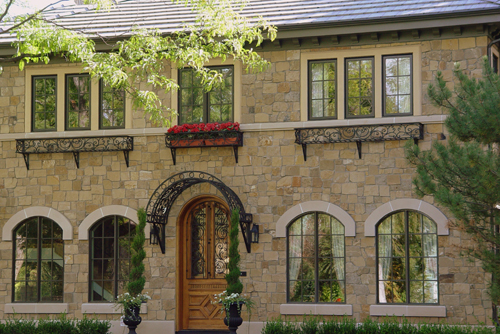Thin Brick and Thin-Cut Stone Take on Full-Dimension Masonry Products
Learning Objectives:
- Discuss characteristics of thin stone and brick veneers
- Specify appropriate design solutions for thin veneers
- Recognize effective installation methods for interior and exterior applications
Credits:
Stone and brick are timeless design materials that have been used for centuries in structures of all types. In one of the fastest growing segments of the masonry products market, adhered natural and manufactured thin stone and brick veneers have become increasingly popular over the past decade in both commercial and residential construction. With slimmer, sleeker profiles, thin stone and brick veneers are being used in projects from interior walls, backsplashes and fireplaces to exteriors of entire buildings - both in new construction and renovations. They are offering architects an expanded palette and added flexibility in decorative masonry, enabling quality and timeless aesthetics in a cost-effective product. Compared to full dimension stoneor masonry veneer, natural thin veneers offer substantial benefits,particularly in terms of engineering, shipping and installation. This article addresses the advantages of natural thin stone and thin brick veneer products, along with their design considerations, installation methods and maintenance issues.
Thin Veneer Defined
A thin veneer is any lightweight, thin surface material that can be applied directly to a solid facing. In contrast to traditional, full-dimension stone or brick masonry, which ranges upwards of four inches or more in depth depending on structure and building needs, the thickness of thin veneer stone ranges from 3/4-inch to 1-1/4 inches, with thin veneer brick ranging from 3/8-inch to 1 inch. Thin veneer, which must weigh 15 pounds or less per square foot as recommended by the Uniform Building Code (UBC), is essentially a facing product. Ledges, footings or wall ties are not necessary because the stone and brick are supported by the wall itself. With no load-bearing foundations required, thin masonry veneers are easier and less expensive to install than their full-dimension equivalents. Engineering costs are less, as is the amount of structural reinforcement required. Its lighter weight and thinner profileenables thin stone and brick veneers to be used in areas that can not support a heavy load, and it is a viable alternative for projects with limited space or other special considerations. Thin veneer can be used in conjunction with thicker masonry, adding flexibility to the architect's design resources. Ninety-degree corners increase thin veneer's authenticity; these L-shaped corners wrap around a column or wall providinga look similar to full thickness veneer.
A few manufacturers have tested thin veneers for freeze/thaw so that they are suitable for all climates in the United States. The better manufacturers have strict specifications for the look of thin veneer stone, with chisel marks or saw cut marks not allowed.
Ready-packaged thin stone and brick veneers have long been relegated to the synthetic variety, but today, there are natural options for thin-cut brick and stone.
 |
Natural thin veneer provides an authentic Tuscan look to the exterior of this custom home. Photo courtesy Roger Reynolds Photography |
Natural Thin Stone Veneer
A lightweight alternative to full veneer, natural thin stone veneer is cut from natural stone quarried from the earth. Technological advances, diamond saws and computers all factor into the quarrying and fabrica-tionprocess to produce these thin, lightweight slices of natural stone.Sedimentary varieties such as limestone, sandstone and quartz-basedstones are some of the most popular options. While thin veneer is available in harder stones such as granite and marble, the fabrication cost may be prohibitive due to the difficulty in sawing extremely denseand hard materials.
Because it is a natural product, thin stone veneer is colorfast, will not fade and resists chipping and scratching. The unique color of natural thin stone virtually eliminates the potential for repeating patterns on large projects.









